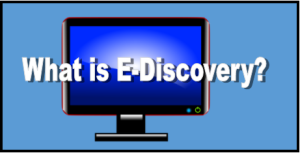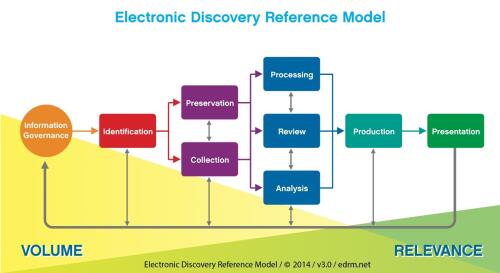What is E-Discovery?
 E-Discovery is discovery involving electronic documents. That’s it.
E-Discovery is discovery involving electronic documents. That’s it.
You’re probably already doing, or have already done, some type of e-discovery. If your client is emailing documents to your attorney, and your attorney forwards those documents to you to prepare for production, then you are working with e-discovery.
But is this the best approach for dealing with electronic documents?
It depends on the scope of the case. If this is an automobile liability case and your client is emailing you the pictures they took from their phone after the accident occurred, there is probably nothing wrong with this approach. However, if your client is involved in a high dollar business dispute, and a lot of the issues in the case arise around who said what when this is probably not the best approach.
What are some of the pitfalls to this approach?
- Completeness. Did your client actually forward you all the relevant documents? How can you be sure?
- Metadata. If your client is sending you emails by forwarding them to your attorney, the metadata of the underlying emails are lost. What is metadata? In a nutshell, the data surrounding the email: who sent it, who received it, when it was sent, what was attached to it, etc.
- How are you going to keep track of all these documents? Sometimes, cases start with a client forwarding the ten to twenty most important documents to their attorney. And if your attorney forwards those to you, that may be a fine way to familiarize yourself with key facts. But if opposing counsel requests emails going back seven years, having your client EMAIL all those to your attorney, who then forward them to you – that is a recipe for disaster.
- The rules of discovery. Federal Rule 34 requires us to identify which documents are responsive to which requests or produce them as they were kept in the ordinary course of business. In the ordinary course of business, your client likely does not forward your law firm their routine business correspondence. The comments of ABA Model Rule 1.1, which addresses competency, specifically address technology. They state: “To maintain the requisite knowledge and skill, a lawyer should keep abreast of changes in the law and its practice, including the benefits and risks associated with relevant technology...” This requires them to at least understand what options you have regarding e-discovery technology. And there are more defensible options than just forwarding via e-mail. Furthermore, if you dive in to the case law across the country, judges are becoming less and less patient with attorneys (and parties) that do not take e-discovery seriously.
So you need a plan. You may not need to use this plan for every new case that comes across your desk, but you will need a plan.
The Electronic Discovery Reference Model (“EDRM”) is a great starting point. What is the EDRM? It’s an organization that “creates practical resources to improve e-discovery and information governance.” You can learn more about the EDRM on their website where they have white papers, guidelines, and more. The site is a little unwieldly, and the standards that will be discussed in this blog series can be found here.
This blog series will focus on specific stages of the EDRM flowchart, which breaks down the different steps required in cases that involve extensive electronic discovery. The flowchart begins with your client’s information governance policies and goes all the way through trial presentation.

As we move through the EDRM process, the volume of our data decreases, and the relevance increases. This is represented by the yellow triangle (volume) and green triangle (relevance) in the flowchart. At the beginning you will start with a whole mess of documents. At the end, ideally, you will have honed in on the most relevant documents for production and trial presentation.
In four additional posts, we will address the following stages in the EDRM flowchart:
- IDENTIFICATION –Who are the most important custodians? Custodians are simply individuals with relevant data. Where are their documents?
- PRESERVATION – Has your client issued a litigation hold?
- COLLECTION – How are you going to collect this data?
- PROCESSING – Once you have the data, how are you going to look through it? What metadata do you want pulled out of it?
- REVIEW – How are you going to review all these documents? It may be unfeasible to review each documents one-by-one.
- PRODUCTION. What are you going to give opposing counsel?
Stay tuned!




